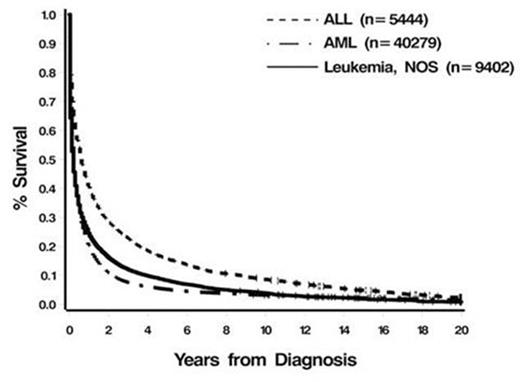Abstract
Introduction: Surveillance, Epidemiology, and End Results (SEER) registry captures data on acute leukemias (AL) that morphologically do not conform to well characterized acute leukemic entities in the established French-American-British (FAB) nomenclature. Not much is known about population level outcomes of these rare AL. We performed a comprehensive survival analysis of these rare AL over a forty-year period using the SEER registry.
Methods: SEER 18 dataset was queried to identify adult patients (pts > 18 years) diagnosed with Acute Myeloid Leukemia (AML), Acute Lymphoblastic Leukemia (ALL) and rare AL from 1973-2012. Rare AL cases were identified using ICD-O-3 morphology codes and included Leukemias, Not Otherwise Specified (NOS) (9800-01, 9860) and myeloid sarcoma (9930). Data on demographics,follow up and survival was abstracted. Univariate and multivariate analysis was performed to identify factors influencing survival of rare AL and survival patterns were compared to AML and ALL. Hazard ratios (HR) with 95% confidence intervals (CIs) are reported.
Results: We identified 61,550 AML pts, 13,457 ALL pts, 525 myeloid sarcoma pts and 13,446 pts with leukemia NOS. Median age at diagnosis was 68 years (yrs, range 18-100) for AML, 54 yrs (18-100) for ALL, 65 yrs (18-95) for myeloid sarcoma and 76 yrs (18-100) for leukemia NOS. Gender distribution was similar with females comprising 45.9% of AML, 43% of ALL, 42.3% of myeloid sarcoma and 47.2% of leukemia NOS cases. Over 80% pts in all categories were Caucasian. Median survival was as follows: 0.4 (0-40) yrs for AML; 1.4 (0-39.8) yrs for ALL; 0.7 (0-32.9) yrs for Myeloid Sarcoma; and 0.3 (0-38.9) yrs for leukemia NOS. In univariable analysis, younger age predicted for better survival for both myeloid sarcoma and leukemia NOS (p<0.0001). Improvement in survival over time period was observed for pts with leukemia NOS (p < 0.0001). In multivariable analysis, advancing age was an independent prognostic factor for rare AL, both as a continuous variable and when categorized as older vs. younger pts using age cutoff of 60 yrs. Compared to younger pts, HR for pts > 60 yrs with rare AL was as follows: 2.68 (2.13-3.37; p <0.0001) for myeloid sarcoma; and 2.18 (2.07-2.31; p<0.0001) for leukemia NOS. No difference in survival over time was seen for myeloid sarcoma. Pts with leukemia, NOS diagnosed in yrs 2006-2012 (HR=0.87; 0.82-0.92; p < 0.0001) had better survival compared to the referent years 1973-80. Race and gender did not impact survival. In multivariable analysis, pts with leukemia NOS did worse overall compared to AML (HR=1.13; 1.11-1.53; p<0.0001) and ALL (HR=1.86; 1.81-1.91; p<0.0001). Interestingly, younger pts had a poorer outcome than AML (HR=1.10; 1.04-1.16; p=0.0003), but pts > 60 yrs had a better outcome (HR=0.93; 0.91-0.95; p<0.0001). Both younger (HR=1.33; 1.26-1.41; p<0.0001) and older pts (HR=1.45, 1.40-1.50: p<0.0001) compared unfavorably to ALL (Figure 1). Pts with myeloid sarcoma had a better survival compared to AML pts (HR=0.77; 0.7-0.85; p<0.0001) (Figure 2). This was uniform for pts <60 yrs (HR=0.77; 0.64-0.93; p=0.006) and > 60 yrs (HR= 0.77; 0.69-0.87; p<0.0001).
Conclusion: Pts with leukemias NOS have poor outcomes compared to AML and ALL but prognosis has improved in recent years. The most probable explanation is identification of prognostic molecular mutations that has allowed accurate risk-stratification of pts using the WHO classification and in turn better selection of treatment strategies. Several reasons have limited our understanding of these rare AL - small numbers, exclusion from clinical trials and wide variability in treatment options used. Efforts at better molecular characterization of these AL holds the most promise for improving outcomes.
Sekeres:Celgene Corporation: Membership on an entity's Board of Directors or advisory committees; TetraLogic: Membership on an entity's Board of Directors or advisory committees; Amgen: Membership on an entity's Board of Directors or advisory committees.
Author notes
Asterisk with author names denotes non-ASH members.




This feature is available to Subscribers Only
Sign In or Create an Account Close Modal